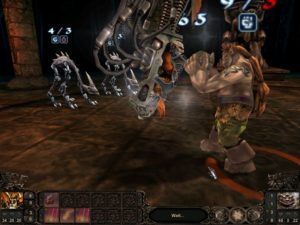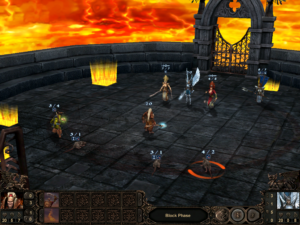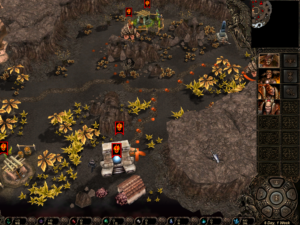Battlegrounds: Final Thoughts
The final chapter of Magic: the Gathering — Battlegrounds consists mainly of fighting all the bosses from the previous chapters a second time, making a mockery of that “Thank you for setting me free” business from earlier. (Poor communication between the scenario designers and the cutscene animators, perhaps?) After that, the game dutifully executes the standard videogame plot twist and the player squares off against the final foe, Mishra.
Mishra uses a five-color deck and doesn’t seem to have a limited mana supply. Fortunately, he’s kind of stupid, and doesn’t take advantage of this by just casting Scorching Missile over and over until you fall down. Instead, he’s fond of summoning big powerful flying creatures, and counterspelling your own attempts to do likewise. A note about counterspell: For it to work, you have to cast it before the opponent finishes casting the spell you want to counter. Since the amount of time it takes to cast a spell seems to be proportional to its mana cost, it’s easier to counter strong spells than weaker ones. This seems kind of backward, but it does generate an interesting point of strategy: when facing an enemy with Counterspell, it makes sense to come up with a strategy that mainly uses weak spells. This generally means summoning fragile creatures in quantity, so that they do a notable amount of damage in total before they die in quantity. The problem is, Mishra also casts Liability, an enchantment that does a point of damage to either caster whenever one of their creatures dies.
After some false starts battling Mishra with Blue (hoping to counterspell the worst of his summons), I wound up using a pure White deck, containing both cheap flying Suntail Hawks (capable of nibbling Mishra’s demons to death, or at least of getting in their way) and various healing effects to help me survive Liability. It strikes me that this may be what the designers were going for here — triumphing with the power of Good. Or maybe not; there could be other effective strategies.
In some sense, I haven’t really finished the game. There’s a single-player Arcade Mode, apparently also winnable, in which you can use whatever colors you’ve unlocked by completing chapters in Quest Mode. (More support for the Quest-Mode-as-tutorial idea.) I’ve tried the beginnings of this, and may even try to win it if it proves easy enough, but as far as I’m concerned, finishing Quest Mode is enough to get this game off the Stack.
And honestly, if I decide I want more single-player M:tG-like experiences, I’ll probably go back to Etherlords. I know I said I was through with that, but a day or two later, I found myself wanting to try the final battle with a black deck. I haven’t really been thinking about Battlegrounds when not playing it or blogging about it, but Etherlords got a firmer grip on my mind, possibly because the realtime aspect of Battlegrounds gives it a chaos-and-confusion aspect that makes it hard for the mind to grasp it in return.
Or maybe it’s just the music. Usually, when I’ve been playing a game for a while, I have the music going through my head throughout the day. After playing Battlegrounds for a few days, I still had the music from Etherlords in my head. Here’s an example of the music from Battlegrounds:
Battlegrounds, blue arena 1
Compare this, from Etherlords:
Etherlords, blue arena 2
Now, I’m not saying that I’d buy a soundtrack CD for either game. But the the music in Etherlords is at least coherent, providing discernable melodic and harmonic structures, while the music in Battlegrounds is a bunch of musical sounds thrown into a blender. This may have been intentional, of course. It’s ambient music, “furniture music” as Satie called it, written with the goal of setting a mood without distracting from the action. And there’s certainly a case to be made for not trying to overlay music with strong patterns of tension and resolution on a game that isn’t gong to fit them. (I remember being strongly struck by the way that the music in Quake II kept on screaming “ACTION SCENE!” while I just stood there in an empty room.) Nonetheless, the end result is that the music in Battlegrounds is so forgettable that you’ve probably already forgotten it in the time it took you to listen to the Etherlords sample and read the rest of this paragraph.
Next post: IF Comp ’08.
 Comments(0)
Comments(0)

